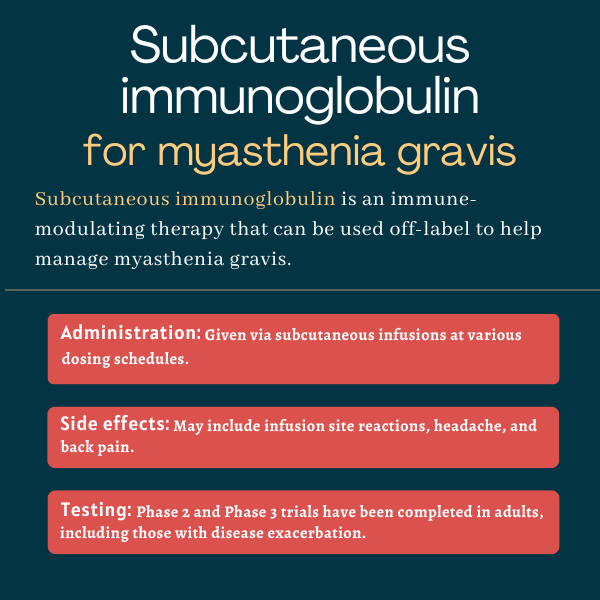 Discussion
Discussion
Subcutaneous immunoglobulin for myasthenia gravis
Last updated Jan. 22, 2025, by Marisa Wexler, MS

What is SCIg for myasthenia gravis?
Subcutaneous immunoglobulin (SCIg) therapy is a type of immune-modulating treatment that’s normally used to manage a variety of immunodeficiency and autoimmune disorders. It broadly works to normalize the activity of the immune system.
No SCIg medications have been specifically approved to treat myasthenia gravis (MG), but some have been tested in MG patients in clinical trials and may be used off-label as part of MG treatment.
Brand names and formulations
All SCIg therapies are administered via an under-the-skin, or subcutaneous, infusion.
While several brands of SCIg therapies are marketed in the U.S., the most well-studied in the context of MG is Hizentra, which is sold by CSL Behring. Hizentra is specifically approved to treat adults and children with primary immunodeficiency diseases, as well as adults with chronic inflammatory demyelinating polyneuropathy — an autoimmune disorder in which the immune system attacks the body’s nerves. It was originally approved in the U.S. in 2010, and is now sold in a number of countries worldwide.
Therapy snapshot
| Treatment name: | Subcutaneous immunoglobulin |
| Administration: | Being tested in myasthenia gravis as subcutaneous infusions |
| Clinical testing: | Has been tested in several clinical trials in adults with myasthenia gravis |
How does SCIg work in myasthenia gravis?
MG is an autoimmune disease in which the immune system makes self-reactive antibodies that interfere with the normal communication between nerve and muscle cells. Disruption of nerve-to-muscle communication gives rise to the typical MG symptoms of muscle weakness and fatigue.
SCIg uses immunoglobulins, or antibodies, that are collected from the blood of healthy donors to modulate the activity of the immune system in a way that helps minimize the autoimmune responses that drive MG. The administered immunoglobulins are thought to help neutralize the self-reactive antibodies that drive MG, in addition to exerting other effects that ultimately reduce the production of these antibodies and promote their elimination from the body.
Treatment with SCIg works in essentially the same way as intravenous immunoglobulin (IVIG) therapy. Both of these treatments use immunoglobulins from healthy donors, which are administered to minimize the effects of the MG-driving autoimmune attack. The key difference is that SCIg is administered subcutaneously, while IVIG is given intravenously, or as an infusion directly into the bloodstream.
How is SCIg administered in myasthenia gravis?
SCIg is given by a subcutaneous infusion, which can be self-administered. The infusion may be done under the skin of the abdomen, upper arm, thigh, or the side of the hip, and is performed with the help of an infusion pump. The dose and frequency depend on several factors, including the indication for which the therapy is being used, the patient’s clinical response to treatment, and the levels of immunoglobulin G in the individual’s bloodstream.
Because SCIg is not officially approved for MG, there is no set standard for dosing in people with the condition. Clinical trials have tested various dosing strategies, often making adjustments based on the individual characteristics of the patients being treated. In these studies, MG patients have received up to four SCIg infusions per week.
SCIg in myasthenia gravis clinical trials
A couple of clinical trials, retrospective studies, and case reports have assessed the effects of SCIg therapy in MG patients. Because data on the use of SCIg in the context of MG is limited, there is no official recommendation for its use in these patients, unlike IVIG.
Phase 2 trial
An open-label Phase 2 study (NCT02100969) assessed the safety and efficacy of Hizentra in more than 20 adults with MG. Participants received one to four infusions of the therapy each week, for 12 weeks, or about three months. Dosing was adjusted based on each individual’s situation.
The study’s main goal was to evaluate the proportion of patients whose Quantitative MG (QMG) scores worsened by no more than three points after 12 weeks on Hizentra — in other words, the proportion of patients who did not have clinically meaningful disease worsening while on the therapy. The QMG scale is a rating tool used to measure the severity of muscle weakness in MG. It scores patients on a scale from zero to 39, with higher values reflecting more severe weakness.
The results showed that 19 of the 22 evaluable patients (86.4%) met this goal. Data also indicated that SCIg treatment was generally safe and well tolerated in these patients.
Phase 3 trial
The University of Alberta in Canada sponsored a pilot open-label Phase 3 clinical trial (NCT02774239) to evaluate the safety and efficacy of Hizentra in adults with MG experiencing an exacerbation, or a sudden worsening of symptoms.
All patients were treated with the SCIg therapy at 2 g/kg in a dose-escalating manner over the course of four weeks. In the first week, the participants received two to three SCIg infusions of 10 mL per site at four sites, for a total dose of 16 to 24 g. During the second week, participants received two to three SCIg infusions of 15 mL per site at four sites for a total dose of 24 to 36 g. In the third week, participants got two to four SCIg infusions of 20 mL per site at four sites for a total dose of 32 to 64 g. In the fourth and final week, participants received two to four SCIg infusions of 25 mL per site at four sites for a total dose of 40 to 80 g. All of these doses could be adjusted by trial investigators based on how patients were responding to treatment.
The study’s main goal was to evaluate how SCIg treatment affected QMG scores after six weeks. A change of at least 3.5 points in the QMG score was considered to be clinically significant.
The trial ended in late 2022, but full results have not been published.
An interim analysis from the first 20 patients who completed the study showed QMG scores dropped (improved) by a mean of 5.12 points after the full course of SCIg treatment. Improvements in the scores of measures of muscle strength and life quality also were seen.

Common side effects of SCIg
Because SCIg therapies aren’t officially approved for MG, the specific safety profile of these treatments in people with MG is not fully known. Yet, clinical trials specifically testing Hizentra in MG patients have reported the occurrence of infusion site reactions, headache, and back pain.
When used in its approved indications, common side effects of Hizentra include:
- infusion site reactions
- headache or migraine
- diarrhea
- nausea and vomiting
- fatigue
- pain in the joints, extremities, upper abdomen, or back
- cough
- upper respiratory tract infection or the common cold, known medically as nasopharyngitis
- fall
- rash
- itching.
Allergic reactions
Severe allergic reactions may occur in response to human immunoglobulin or components of SCIg products. The risk is higher in individuals with antibodies against IgA, a type of immunoglobulin.
SCIg is contraindicated for, or should not be administered to, anyone with a history of allergic reactions to human immunoglobulin or inactive ingredients of these therapies. If an allergic reaction occurs, treatment must be discontinued immediately, and appropriate supportive care should be provided.
Thrombosis
Excessive blood clotting leading to blood vessel obstruction, or thrombosis, may occur following the administration of immunoglobulin products, including Hizentra, which is noted in a boxed warning in the therapy’s prescribing information.
The risk of thrombosis is higher for people who are older, those who are less mobile, individuals who have underlying conditions that make them more prone to have blood clots, and people taking estrogen-containing medications, such as birth control pills.
SCIg therapy should be given at the lowest practical dose and infusion rate in patients at risk of thrombosis. Additionally, patients should be closely monitored for potential signs of thrombosis.
Aseptic meningitis syndrome
Aseptic meningitis syndrome (AMS), a condition characterized by inflammation of the membranes that surround the brain and spinal cord, can also occur following SCIg treatment.
AMS usually develops a few hours to two days after treatment. Symptoms may include severe headache, rigidity in the neck, drowsiness, fever, pain following exposure to bright light, known as photophobia, painful eye movements, nausea, and vomiting. Patients showing possible signs of AMS should undergo a thorough neurological examination to confirm the diagnosis and rule out other potential causes of meningitis. AMS can resolve without long-lasting consequences within a few days of stopping immunoglobulin treatment.
Kidney dysfunction or failure
The use of human immunoglobulin products may lead to acute kidney dysfunction or failure, which in some cases can be life-threatening.
Kidney function should be closely monitored in patients receiving these therapies, especially in individuals with known risk factors for kidney dysfunction, such as advanced age, pre-existing kidney disease, or diabetes. Lower and more frequent dosing may also be considered in such cases. If patients show signs of worsening kidney function it may be necessary to discontinue SCIg treatment.
Hemolysis
SCIg therapy may lead to hemolysis, or the destruction of red blood cells, which can result in anemia. Patients receiving SCIg should be monitored for signs and symptoms of hemolysis. If such signs are observed, appropriate laboratory tests should be conducted to confirm the diagnosis.
Transfusion-related acute lung injury
Transfusion-related acute lung injury or TRALI, a condition marked by fluid buildup in the lungs that impairs breathing, may occur following treatment with human immunoglobulin products. TRALI usually develops within a few hours after treatment. If this lung complication occurs, appropriate testing should be performed and patients should receive supportive treatment, such as oxygen therapy or ventilation, to assist with breathing.
Transmission of infectious agents and laboratory tests
Because SCIg therapies are derived from human blood, there is a theoretical risk of transmitting bloodborne infectious agents. However, with modern quality control systems, this risk is exceedingly low, and no infections specifically associated with the use of Hizentra have ever been reported.
Also, because SCIg treatment entails the administration of antibodies from other people, it is possible that treatment may lead to irregular results in laboratory tests looking for certain types of antibodies. Clinicians should interpret laboratory tests with caution in such cases.
Use in pregnancy and breastfeeding
No data are available on the use of Hizentra in pregnant women, so it is not known whether the therapy can harm a developing fetus. Hizentra should only be administered to pregnant women if clearly needed, as indicated in its prescribing information.
There is also no data on the use of Hizentra during breastfeeding to inform a potential drug-associated risk. The benefits of breastfeeding should be weighed against the mother’s clinical need for treatment and any potential side effects to the infant.
Myasthenia Gravis News is strictly a news and information website about the disease. It does not provide medical advice, diagnosis, or treatment. This content is not intended to be a substitute for professional medical advice, diagnosis, or treatment. Always seek the advice of your physician or other qualified health provider with any questions you may have regarding a medical condition. Never disregard professional medical advice or delay in seeking it because of something you have read on this website.
Related content
-
 Discussion
Discussion
-
-
-




